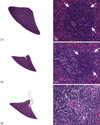Enhanced histopathology of the immune system: a review and update
- PMID: 22089843
- PMCID: PMC3465566
- DOI: 10.1177/0192623311427571
Enhanced histopathology of the immune system: a review and update
Abstract
Enhanced histopathology (EH) of the immune system is a tool that the pathologist can use to assist in the detection of lymphoid organ lesions when evaluating a suspected immunomodulatory test article within a subchronic study or as a component of a more comprehensive, tiered approach to immunotoxicity testing. There are three primary points to consider when performing EH: (1) each lymphoid organ has separate compartments that support specific immune functions; (2) these compartments should be evaluated individually; and (3) semiquantitative descriptive rather than interpretive terminology should be used to characterize any changes. Enhanced histopathology is a screening tool that should be used in conjunction with study data including clinical signs, gross changes, body weight, spleen and thymus weights, other organ or tissue changes, and clinical pathology. Points to consider include appropriate tissue collection, sectioning, and staining; lesion grading; and diligent comparison with concurrent controls. The value of EH of lymphoid organs is to aid in the identification of target cell type, changes in cell production and cell death, changes in cellular trafficking and recirculation, and determination of mechanism of action.
Figures





References
-
- Basketter DA, Bremmer JN, Buckley P, Kammuller ME, Kawabata T, Kimber I, Loveless SE, Magda S, Stringer DA, Vohr HW. Pathology considerations for, and subsequent risk assessment of, chemicals identified as immunosuppressive in routine toxicology. Food Chem Toxicol. 1995;33:239–243. - PubMed
-
- Cesta MF. Normal structure, function, and histology of mucosaassociated lymphoid tissue. Toxicol Pathol. 2006a;34:599–608. - PubMed
-
- Cesta MF. Normal structure, function, and histology of the spleen. Toxicol Pathol. 2006b;34:455–465. - PubMed
Publication types
MeSH terms
Grants and funding
LinkOut - more resources
Full Text Sources
Other Literature Sources
Medical

